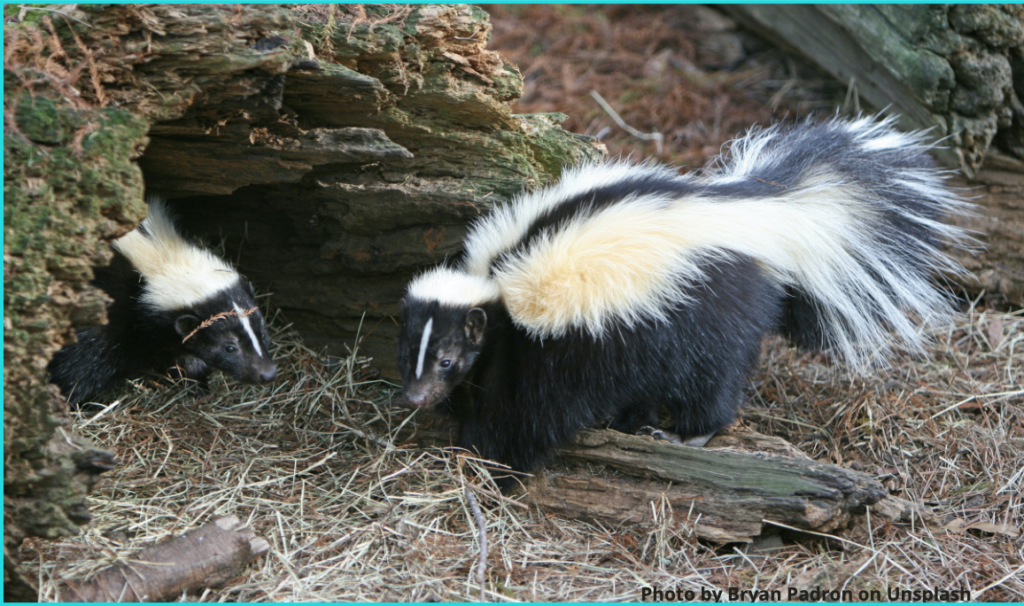What to do if you encounter a skunk in CVNP
It’s not unusual to see wildlife out and about when exploring Cuyahoga Valley National Park – bird, bug, deer and squirrel spottings happen daily! But there are also a lot of critters living in CVNP that we don’t see very often, and sometimes, that makes it a little unnerving when they appear. We recently found ourselves in this situation while heading to the park bright and early for Kickin It with Kenny – a family of skunks made a guest appearance in the background!
Skunks 101
Skunks are nocturnal, meaning they are active from dusk to dawn. However, they can be spotted at all times of the day. Skunks are usually solitary animals except when rearing their young. They’re “opportunistic omnivores,” meaning they will forage whatever they can find: insects, small mammals, eggs, cat food, fruit, nuts, your trash, etc. This is one of the many reasons it’s important to always pack out what you bring in – leaving garbage behind can attract skunks and upset their stomachs.
Defense

Skunks don’t have particularly good eyesight or hearing, which means it’s pretty easy to sneak up on one – which is not something you want to do! You can help prevent spooking skunks by always taking a flashlight with you and keeping your dog on a leash. Skunks typically give warnings before resorting to their ultimate, stinky weapon. Some warning signs include:
- Running away if they see you.
- If you’re too close for them to run away (they have pretty short legs and aren’t the fastest creatures), they shoot their tails straight up and arch their backs. Their black and white fur helps them stand out in the woods, giving other animals – including humans – a chance to see them and get away.
- If they’re still feeling threatened, they’ll start the acrobatics! They rear on their front legs and stomp their feet – a bit like a handstand.
If whatever they feel threatened by still hasn’t left, they resort to spraying.
Try to get away
If you are lucky enough to see the signs, quietly and slowly back away at a diagonal. Loud noises or quick movements may spook the skunk into spray mode, so staying calm is important. Backing up at a diagonal may help you to avoid a spray directly. During a skunk’s handstand, it is possible to get sprayed while the skunk is facing forward. And don’t be fooled by baby skunks – just because they’re extra adorable doesn’t mean they won’t spray, too!
You got sprayed, but it’s ok!
Sometimes even if we try to leave a skunk alone – or never see it to begin with – we end up getting sprayed. A skunk’s spray is a sulfuric oil-based liquid called thiols excreted from glands located near the base of the tail. A skunk can spray this liquid up to 15 feet. If you are sprayed in the eyes it can be very painful and cause temporary blindness. Flush immediately with cold water, and call a doctor if symptoms persist. The spray can also cause nausea and vomiting but quite frankly, most of the time it just makes you stink.
If you need to get into your car to go home, make sure to take off as many layers as you can to reduce the chance of getting the oil on your upholstery. Put your items in your trunk (ideally in a bag). Contrary to popular belief, tomato juice does not work to get rid of the smell, it can just mask the smell. To get rid of smells you must use ingredients that can oxidize and break down the oil in a skunks spray.
Here’s a solvent recipe shared by Outbound Collective:
- 1 quart 3% hydrogen peroxide
- 1/4 cup baking soda
- 1 teaspoon dish soap
Using this mixture, you can get rid of the smell but it will take several days. Patience is key when you have been sprayed.
Don’t let skunks put you in a funk
In general, it isn’t likely you will see skunks while enjoying Cuyahoga Valley National Park, but if you do, keep in mind that the skunk does not want to harm you. These tips will help make sure you, and the animals that call CVNP home, all stay safe:
- Always observe wildlife from a distance. Do not spook them or try to touch them.
- If a skunk starts showing warning signs, slowly back away diagonally. Do not run, make loud noises or throw things.
- Keep your dog(s) on a six foot-leash at all times.
- If you do get sprayed, don’t panic. Try to remove extra layers that have the oil on them and avoid spreading the oil.
- Pack out what you take in – do not leave food or garbage in the park.
- Baby skunks are adorable, but they also get spooked! Do not touch baby skunks – they can spray, too, and chances are mom and/or dad is nearby and will not be happy.
Take our Skunk Quiz!
Results
#1. The stripes on a skunk point to what?
#2. What time are skunks most active?
#3. True or False? Baby skunks can't spray so it is fine to pet them.
#4. What is the scientific name of a skunk?
#5. What is a group of skunks called?
#6. BONUS: Is skunk spray flammable?
The Conservancy is a nonprofit friends group for Cuyahoga Valley National Park. Our goals are to improve visitor experiences, and provide meaningful, life-enhancing programs to our communities. If you would like to join us in protecting the Cuyahoga Valley National Park, please consider supporting your park today.
Special thanks to Outbound Collective for their solvent recipe and information on skunks!








